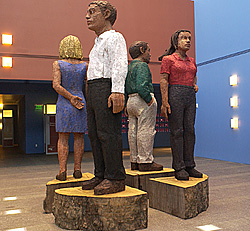 |
A sculpture by Stephan Balkenhol was installed in the community center on Oct. 21, 2005. Photo by Christine Jegan. |
Contemporary works of public art are an integral part of UCSF Mission Bay's development, contributing to the campus community's cultural identity and experience.
Catalysts for conversation around campus, "the uniquely varied works of art animate the urban landscape and bring a sense of discovery to the interiors of its buildings," says Mathieu Gregoire, Mission Bay art consultant.
The growing collection of art features large-scale sculptures, furnishings, paintings, drawings and photographs by various artists.
An ardent advocate of the arts, Chancellor Mike Bishop pledged 1 percent of all new Mission Bay campus construction costs to establish initial funding for the public art program, later to be supplemented by gifts. As is the case at other UCSF sites, Bishop wants to enrich campus life at Mission Bay by integrating a wide range of art into public spaces that reflects the diversity of the community and represents various artistic disciplines and points of view.
"Our purpose is to create an environment that will be a credit and benefit to the entire community, a stimulating and pleasant place to work and visit, a permanent legacy to the city," said Chancellor Bishop when he appointed the Mission Bay Art Planning Committee to develop a world-class public art program at the new campus in March 1999.
Composed of faculty, staff and students, the committee works closely with an art advisory board, created at the committee's recommendation to guide its efforts. The board comprises four art experts who together assist in the selection of artists by making recommendations to the committee. Ultimately, the committee recommends commissions, acquisitions and loans of works for the campus to the chancellor.
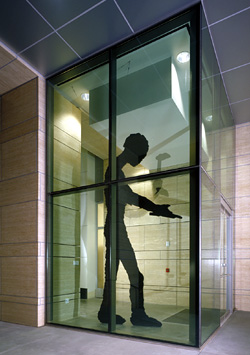 |
Hammering Man at 2,903,440 by Jonathan Borofsky, on loan to UCSF from the San Francisco Museum of Modern Art. Photo by Mark Citret. |
For Sam Barondes, chair of the art committee and professor of psychiatry, the investment in major works of public art at Mission Bay is a once-in-a-lifetime opportunity. "It's been a great treat for the committee to participate in the enrichment of this glorious new campus by working so closely with such talented artists and advisers," he says. "We look forward to continuing our efforts to expand the collection."
Here's a look at the artists who have brought their unique and powerful expression of artistic vision to UCSF Mission Bay.
Stephan Balkenhol
Born in 1957, Stephan Balkenhol lives and works in Karlsruhe, Germany, and Meisenthal, France. He studied at the Hochschule für Bildende Künste in Hamburg. His work in rough-hewn painted wood and cast metal has contributed to a rediscovery of the figure, especially as it relates to architecture. Balkenhol frequently works with scale and context in unexpected ways, representing people, animals and sometimes combinations of the two.
For his commissioned work installed in the light-filled atrium of the campus community center in October 2005, Balkenhol carved four standing figures out of the trunk of a single tree. Each quarter section of the tree is carved into a figure, integral with its base. The figures, elevated and outsized, facing in different directions, mediate between human scale and the scale of the 80-foot-tall atrium space. They express its function as a place where different people cross paths.
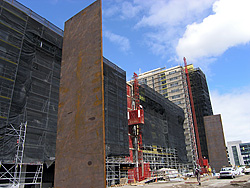 |
Standing 133 feet apart, Ballast, designed by American sculptor Richard Serra, was erected on March 22, 2005. Photo by Majed. |
Jonathan Borofsky
Born in 1942, Jonathan Borofsky lives and works in Los Angeles. He earned his BFA degree from Carnegie-Mellon University, a CT degree from Ecole de Fontainebleau and an MFA degree from Yale School of Art & Architecture. Borofsky uses memories and especially dreams as the source material for all his work. He numbers everything he creates sequentially - regardless of whether it is a scrap of paper or a monumental sculpture.
His 1984 work, titled "Hammering Man at 2,908,440," is on loan to UCSF from the San Francisco Museum of Modern Art. Made of painted wood, aluminum, steel and electric motor, the sculpture was installed in July 2005 in the main entry to the California Institute for Quantitative Biomedical Research, or QB3. One of Borofsky's best-known images, "Hammering Man" expresses his respect for work and repetition. The repetitive motion of this kinetic sculpture and its prominent identifying number echo the fusion of math and biology being explored at QB3.
Mark Citret
Born in 1949, Mark Citret lives in San Francisco. He earned BA and MA degrees at San Francisco State University. His photography is known for its formal elegance, as well as for capturing fleeting and unexpected moments.
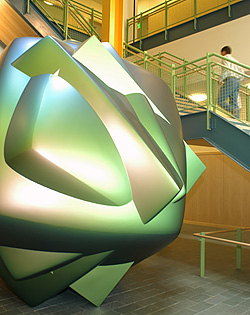 |
This 12-foot sculpture by Los Angeles-based artist Liz Larner is the centerpiece in the lobby of Arthur and Toni Rembe Rock Hall. Photo by Elisabeth Fall. |
His commissioned black-and-white photographs can be seen in numerous locations at the Mission Bay and Parnassus Heights campuses. These photographs of construction materials, sites, buildings and processes will archive the physical evolution of UCSF Mission Bay. The artist makes regular visits and records objects as he sees them at different times of the day.
Jim Isermann
Born in 1955, Jim Isermann lives and works in Palm Springs. He earned his BFA degree at the University of Wisconsin, Milwaukee and an MFA degree at the California Institute of the Arts. For 25 years, Isermann has developed a vocabulary that purposefully encompasses the intersection between art and design, unapologetically appropriating from mid-century design. Combining sculpture, furniture and architecture, his bold geometries have influenced a generation of artists who are currently exploring similar territory.
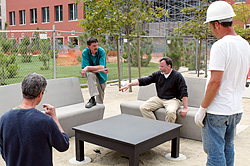 |
Discussing the arrangement of furniture in the Koret Quad at UCSF Mission Bay are, from left, Mathieu Gregoire, Scott Graczyk, Roy McMakin and Eric Aasen. Photo by Elisabeth Fall.
|
Isermann's commissioned chandelier project, installed in May 2003 in the atrium of Genentech Hall, complements the carpet and furniture that surround the piece. The five-pendant chandelier is suspended at the west end of the 100-foot-tall space, each pendant comprising luminous spheres enclosed in an open lattice of red pentamerous shapes. Modernist furniture selected by Isermann is placed throughout the atrium, as well as carpeting designed by the artist. The shape, scale, design and colors of chandelier, furniture and carpet pattern relate to one another.
The chandelier is made of powder-coated aluminum, steel and polycarbon. The carpet was made from wet dye injection-printed nylon. The furniture Isermann selected includes Bertoia side, diamond and large diamond chairs, Mies van der Rohe Barcelona tables and Eames dining tables.
Liz Larner
Born in 1960, Liz Larner lives and works in Los Angeles. She earned a BFA degree from the California Institute of the Arts. Larner's work combines geometric form with a pervasive sense of movement and change. Over a period of 20 years, she has used a wide range of materials to create environments that engage the formal language of Minimalism to question its own precepts and assumptions.
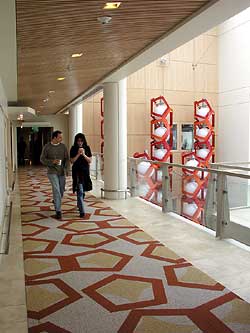 |
With the new hanging light sculpture by Jim Isermann as dramatic backdrop, UCSF students walk toward the main elevators of Genentech Hall. Photo by Majed. |
Her work, titled "2001," was acquired with placement determined by the artist in the lobby of Arthur and Toni Rembe Rock Hall in May 2004. It is made of fiberglass, paint and steel. "2001" is a 12-foot-diameter object generated using animation software to represent six equal steps in a progression from a sphere to a cube, superimposed upon each other. The resulting form, precisely fabricated in epoxy resin, is complex and asymmetrical, and its appearance changes constantly as one moves around it because of the unique refractive properties of the paint surface - at once green and magenta.
Roy McMakin
Born in 1956, Roy McMakin lives and works in Seattle, Washington. He earned his BA and MFA degrees at UC San Diego. McMakin's work addresses the design and use of domestic environments, finding in them unexpected and hidden associations. Subtle and highly crafted, his furniture and his art explore the nature of function, ornamentation, decoration and celebration in both public and private life.
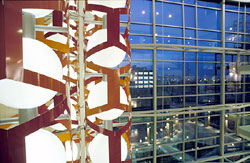 |
Jim Isermann chandelier in Genentech Hall. Photo by Majed. |
His untitled collection of furniture was installed in the Koret Quad in July 2004. McMakin's materials include concrete, fiberglass, wood, bronze, enamel, steel and stone. The commissioned work features double-sided concrete benches, which are arranged in a regular pattern around the perimeter of Mission Bay's primary outdoor space. The furniture is sliced, transformed and rearranged in various ways.
The work includes a wide variety of objects - all functional as seating - including enamel laboratory refrigerators and banker's boxes, and typical office and patio chairs cast in bronze. There are also natural boulders, bronze tree stumps and planks.
Richard Serra
Born in 1939, San Francisco native Richard Serra lives and works in New York City and Nova Scotia. He earned BFA and MFA degrees from Yale University. One of the foremost artists of his time, Serra has redefined the idea of sculpture since the 1960s, making the experience of site, time and movement essential. For Serra, it's not as much about the objects he introduces as it is about the individual experience of the viewer in relation to the whole context, measured and defined by his massive interventions.
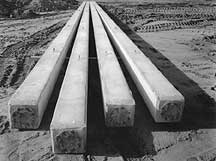 |
Bay Area photographer Mark Citret has been commissioned to capture the construction of the UCSF Mission Bay campus for the historical record and to create an exhibition for the campus community. This slide show features his work over the last two years. View slide show in Flash format |
Installed in the campus plaza in March 2005, his commissioned work, titled "Ballast," awaits completion of the surrounding plaza in the summer of 2006. The work consists of two plates of weatherproof Cor-Ten steel, each measuring 49'2" by 14'9" by 5" and weighing 70 tons each. The steel plates are located at equal distances from the ends of the space and from each other, dividing the plaza lengthwise into three equal intervals. Each plate tilts 18" sideways in the opposite direction from the other. The scale, weight, placement and angle of the steel plates animate the whole space, and their relationship changes continuously as one moves around.







